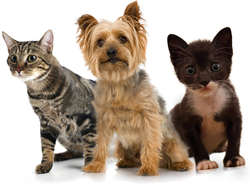Pet Meal Prep: How to Batch Cook and Freeze Healthy Meals for Your Dog or Cat
- Ryan S.

- Aug 3
- 4 min read
Forget Sunday meal prep for yourself—it's time to fill the freezer with fresh, healthy meals for your furry companions. Pet meal prep is the latest lifestyle trend pet parents are obsessing over—and it’s more rewarding (and economical) than you might think.

Why Pet Meal Prep Is Taking Over the Pet World
We already prep lunches for work and dinners for the week—so why not apply the same love and logic to our pets’ meals?
Batch-cooking meals for dogs and cats has become a rising trend among health-conscious owners. It lets you control the ingredients, skip fillers and preservatives, and tailor your pet’s meals to their specific needs. Whether your dog needs low-fat food or your cat prefers poultry over fish, meal prep gives you full control—without daily cooking stress.
According to a 2023 Pet Food Industry report, homemade pet food now accounts for over 10% of the U.S. pet food market, with millions of owners preparing at least part of their pet’s meals from scratch.

Benefits of Batch Cooking for Your Pet
✔️ Customization – Perfect for picky eaters, allergies, or breed-specific sensitivities ✔️ Cost-effective – Often cheaper than premium pet food brands ✔️ Transparency – No mystery meat or unpronounceable additives ✔️ Convenient – Freeze individual portions and thaw as needed ✔️ Bonding – Preparing your pet’s food creates a stronger connection

What Makes a Homemade Pet Meal Balanced?
Before you start sautéing chicken thighs and sweet potatoes, it's important to know that dogs and cats have very different dietary needs:
Dogs are omnivores
They benefit from a mix of protein, vegetables, grains, and healthy fats.
Cats are obligate carnivores
They require high protein and certain nutrients (like taurine) found only in animal products.
If you’re not working with a vet or animal nutritionist, start with basic supplement-friendly recipes or pet food kits that are formulated to be nutritionally complete.

Must-Have Ingredients for Dog Meal Prep
Proteins: Ground turkey, chicken thighs, beef, lamb
Veggies: Carrots, green beans, peas, spinach (all cooked and chopped)
Carbs: Brown rice, oats, sweet potatoes, quinoa
Fats: Fish oil, olive oil, flaxseed oil
Supplements: Calcium (egg shell powder or bone meal), dog-specific multivitamin
Sample Dog Meal Prep Recipe:
2 lbs ground turkey
1 cup cooked brown rice
1 cup chopped, steamed carrots
1/2 cup cooked peas
1 tbsp fish oil
Optional: Dog vitamin mix per vet instruction
Makes 6–8 portions for a medium-sized dog.

Essential Ingredients for Cat Meal Prep
Proteins: Chicken, turkey, rabbit, beef (must be fully cooked)
Organ meats: Liver, heart (in small amounts, essential for taurine)
Supplements: Taurine, calcium, B vitamins, vitamin E, and omega-3
No grains needed – cats don’t require carbohydrates
Optional veggies: Tiny amounts of pumpkin or zucchini, if tolerated
Sample Cat Meal Prep Recipe:
1 lb cooked ground chicken
2 oz cooked chicken liver
1 tbsp salmon oil
500 mg taurine supplement
1/4 tsp egg shell powder or crushed eggshell
Optional: Pinch of pumpkin puree for digestion
Makes 6–10 small feline portions.

Batch Cooking Tips: Make It Easy and Safe
Cook meats thoroughly to eliminate pathogens (no raw unless under vet supervision)
Cool before portioning into freezer-safe containers
Label and date each container (especially if you prep multiple recipes)
Freeze in individual servings for easy thawing—ice cube trays or silicone molds work great for small pets
Thaw overnight in the fridge before serving (never microwave plastic directly)

Storage Guidelines for Homemade Pet Food
Refrigerator: Up to 3 days
Freezer: Up to 3 months (airtight containers or vacuum sealed)
Do not refreeze thawed meals—use within 24 hours once defrosted

How Much to Feed? Portion Control Matters
Feeding amounts vary by pet size, age, activity level, and recipe, but here’s a general guide:
For Dogs:
2–3% of body weight per day in food (split into two meals)
Example: A 40-lb dog would eat about 1 lb of food daily (8 oz per meal)
For Cats:
4–6 oz per day, split into two meals
Adjust if they’re overweight, active, or very small
Tip: Use a digital scale to portion accurately—and consult your vet to be sure.

Supplement Smart: Why Vitamins Matter
Homemade pet meals can be nutritionally incomplete without supplements, even with great ingredients. Always include:
Calcium – bones or bone meal powder
Taurine (for cats) – essential for heart and eye health
Omega-3s – fish oil supports skin, coat, and brain
Multivitamins – tailored to species (don’t use human vitamins!)
Brands like BalanceIT, Dr. Harvey’s, or The Honest Kitchen offer supplement mixes that make this process easier and safer.

Time-Saving Tricks for Pet Meal Prep Pros
Invest in a second slow cooker or Instant Pot—one for you, one for them
Prep double batches and freeze half for later
Use silicone freezer molds for portioned “pet bricks”
Color code containers (e.g., blue lids for cats, red for dogs)
Create a weekly menu to rotate proteins and avoid boredom
Final Chew: Pet meal prep empowers you to feed your pet fresh, tailored, and healthy meals
Batch cooking saves time and money while reducing waste
Balanced recipes + supplements = a happier, healthier pet

Disclaimer:
The content provided in this article is for informational and entertainment purposes only. I am not a veterinarian or licensed animal health professional. The information presented here is based on personal experience, research from reputable sources, and general pet care knowledge, but it should not be considered medical advice. Always consult with a qualified veterinarian or pet nutritionist before making any changes to your pet’s diet, health routine, or care regimen. Each pet is unique, and professional guidance is essential to ensure their safety and well-being.








Comments